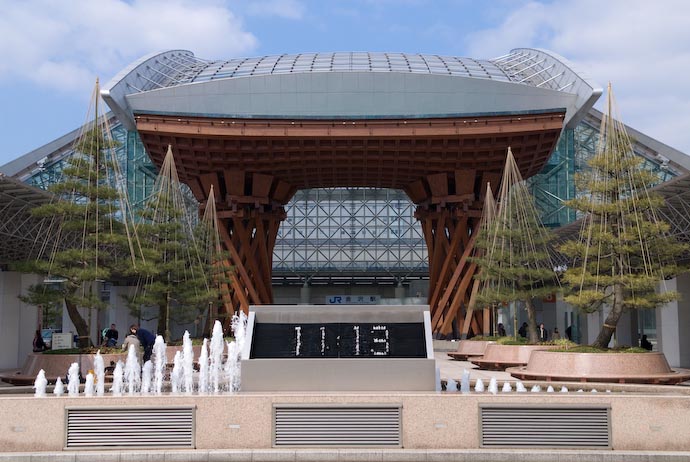
Nikon D200 + Nikkor 17-55mm f/2.8 @ 31 mm — 1/1000 sec, f/5.6, ISO 250 — map & image data — nearby photos
Kanazawa Station
the quintessential shot that everyone gets
( but it requires good timing, because you have to stand in the middle of a large intersection to do so )
Last March, Fumie and I traveled to the city of Kanazawa to see Kousuke Atari in concert, and while photography is not allowed during the concert, Japan always offers plenty to enjoy in that respect. I've already posted about Kanazawa's Kenrokuen Gardens, and some hotel-lobby wedding-party shots I took.
Today, I'll post about the geometrically-rich entrance atrium of Kanazawa's JR (Japan Railway) station, one scene from which was the lead photo of my embarrassment of riches post some time ago.
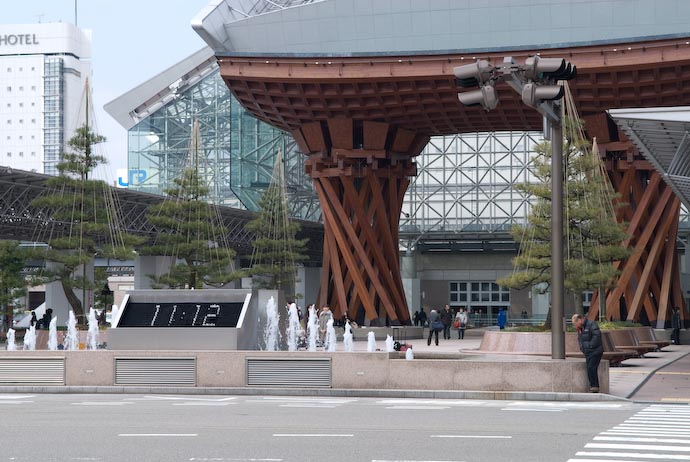
Nikon D200 + Nikkor 17-55mm f/2.8 @ 55 mm — 1/250 sec, f/8, ISO 250 — map & image data — nearby photos
Modern Traditional
The main feature when viewed from the front is a strongly modern (postmodern?) interpretation of a traditional Shinto shrine gate. Compare to the gate at the Itsukushima Shrine on Miyajima (here, here, and here), or to the more recent (decidedly modern at only ~80 years old) gate at the Heian Shrine (here and here).
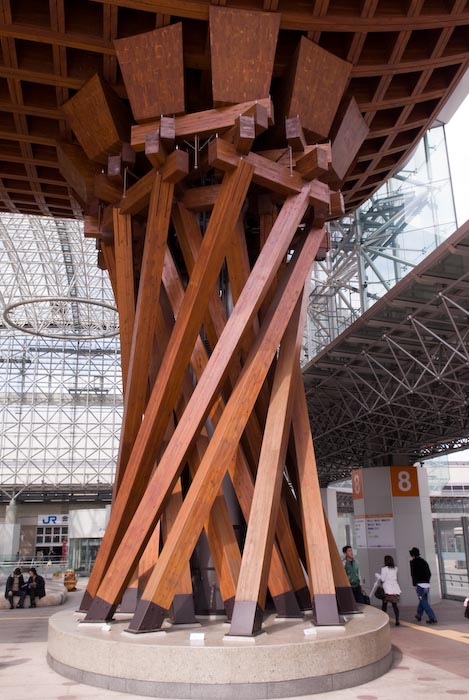
Nikon D200 + Nikkor 17-55mm f/2.8 @ 22 mm — 1/100 sec, f/7.1, ISO 125 — map & image data — nearby photos
Massive Leg
Reading now on Wikipedia, I see that this gate is referred to as the “Drum Gate”, since each leg looks like a kotsuzumi drum (one whose heads are bound with cords that can be squeezed to change the pitch as one plays, as can be seen in this recent post about Noh Theater).
Between the gate and the building proper is a huge glass-covered atrium (that's actually covered by some kind of plastic, if the wonky effect it had on my camera's polarizing filter is to be understood).
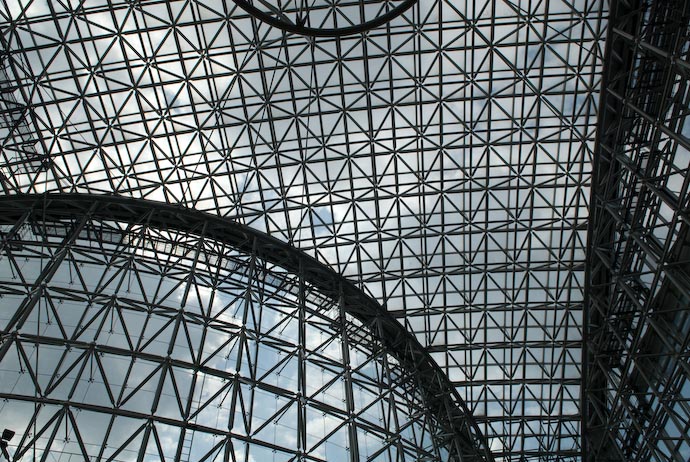
Nikon D200 + Nikkor 17-55mm f/2.8 @ 17 mm — 1/320 sec, f/9, ISO 250 — map & image data — nearby photos
Atrium Enclosure
makes me want a wider angle lens
Within the atrium – called the “Hospitality Dome” in Japanese – is a little stream, benches, etc., all in a style that mixes “modern” and “comfortable” in a way I would not have thought possible. I don't care for “modern” architecture, and even less so for “modern art”, but this was a very enjoyable space, both visually and in general ambiance.
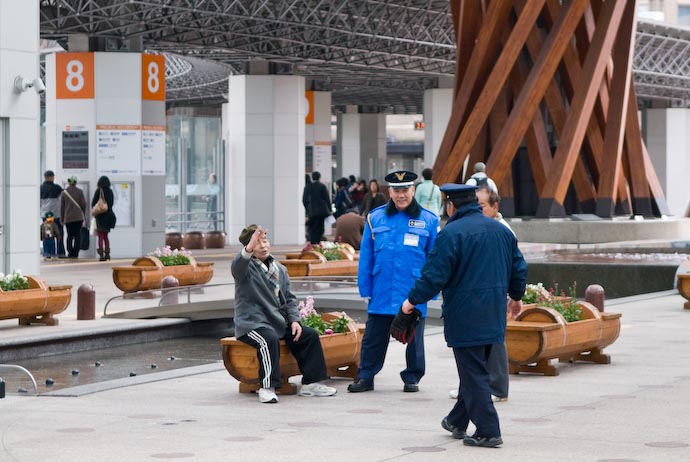
Nikon D200 + Nikkor 17-55mm f/2.8 @ 55 mm — 1/640 sec, f/3.2, ISO 250 — map & image data — nearby photos
these guys appear to be
Old Friends
It wouldn't surprise me in the least if they all used to be station security guards together, and the guy sitting has retired but still comes to visit for hours on end.
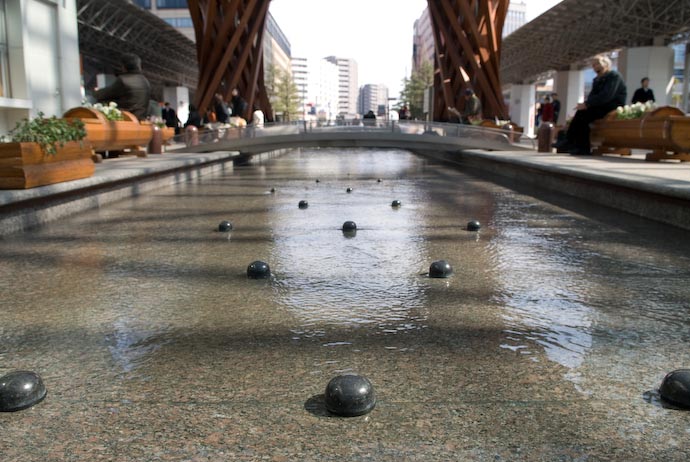
Nikon D200 + Nikkor 17-55mm f/2.8 @ 17 mm — 1/125 sec, f/6.3, ISO 100 — map & image data — nearby photos
“River”
I bet kids play in here a lot
The little “river” flows from just behind the gate, past a bunch of benches, under a walkway, then flows over a waterfall down to a pool two levels below ground.
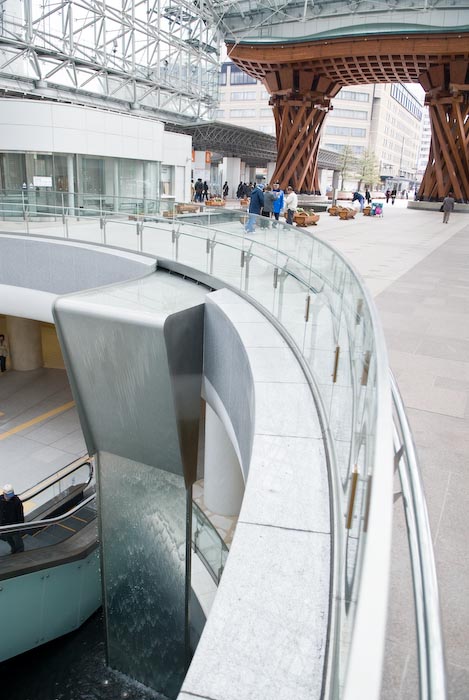
Nikon D200 + Nikkor 17-55mm f/2.8 @ 17 mm — 1/640 sec, f/3.2, ISO 250 — map & image data — nearby photos
Flow
In this respect – art and architecture meshing on multiple levels – Kanazawa Station is somewhat similar to Kyoto Station. Kyoto Station is much larger on every scale, and much more fun to explore, but I've got to say that the esthetic sense of Kanazawa Station – presenting “old” in a new but somehow familiar and unified way – was really nice.
In the first two shots of this post, you perhaps noticed that the clock smack center in the front of the station is the answer to the What Am I? quiz from last week. Here's a closer view...
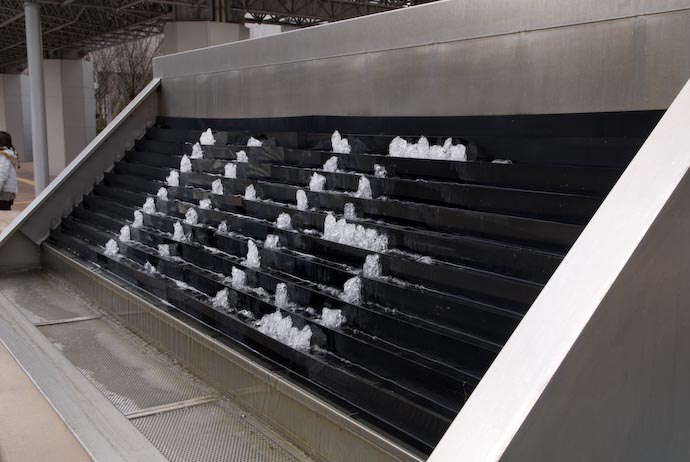
Nikon D200 + Nikkor 17-55mm f/2.8 @ 26 mm — 1/80 sec, f/11, ISO 125 — map & image data — nearby photos
Clock
The same display was on either side, so it also faced the atrium/station as well. Sometimes the time was replaced with the temperature or a message, so perhaps the answer to the quiz is really “message board”. I would have accepted “clock”, but no one even came close, so this week's bevy of fabulous prizes go unawarded.
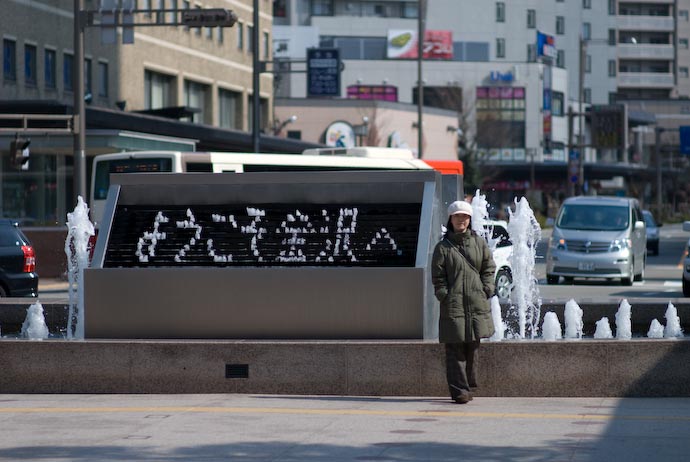
Nikon D200 + Nikkor 85mm f/1.4 — 1/5000 sec, f/1.8, ISO 250 — map & image data — nearby photos
“Welcome to Kanazawa”
I recently visited Kanazawa and found your page while looking for more information about the construction and design of the railway entrance. Great photos! I’m off to explore other parts of your blog now.
Nick
I’m going to Kanazawa (and Kyoto and Tsumago and Shirakawago) in November 2010 and am really looking forward to the architecture at the train stations. You have done an exquisite job on these photos — and I really appreciate how you go do more research on the things you don’t understand at the time you are photographing (such as Noh) and that you link such interesting information and photos.
What a find you are. I have already marked this on Facebook and will send your blog link to my photographer partner, Anthony Sawers.
BTW we live in Glebe (Sydney) Australia. I’ve been to Japan before, but there’s so much more to absorb.
All the best.
M~
hay
do you know the name of the archtecther of kanazawa train station gate ?
No, but Google tells me it’s this company —Jeffrey